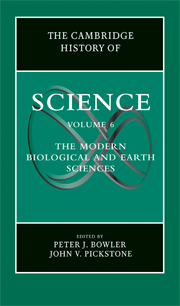Book contents
- Frontmatter
- 1 Introduction
- PART I WORKERS AND PLACES
- 2 Amateurs and Professionals
- 3 Discovery and Exploration
- 4 Museums
- 5 Field Stations and Surveys
- 6 Universities
- 7 Geological Industries
- 8 The Pharmaceutical Industries
- 9 Public and Environmental Health
- PART II ANALYSIS AND EXPERIMENTATION
- PART III NEW OBJECTS AND IDEAS
- PART IV SCIENCE AND CULTURE
- Index
- References
4 - Museums
from PART I - WORKERS AND PLACES
Published online by Cambridge University Press: 28 November 2009
- Frontmatter
- 1 Introduction
- PART I WORKERS AND PLACES
- 2 Amateurs and Professionals
- 3 Discovery and Exploration
- 4 Museums
- 5 Field Stations and Surveys
- 6 Universities
- 7 Geological Industries
- 8 The Pharmaceutical Industries
- 9 Public and Environmental Health
- PART II ANALYSIS AND EXPERIMENTATION
- PART III NEW OBJECTS AND IDEAS
- PART IV SCIENCE AND CULTURE
- Index
- References
Summary
Whereas the general public experiences a natural history museum as a series of educational displays, particularly of fossils and stuffed animals, the scientific importance of these institutions lies in the much larger collections of specimens behind the scenes that make possible an inventory and analysis of the world’s diversity. The history of natural history museums is more often studied as part of the history of culture rather than as belonging to the history of science, but the role of well-documented collections as an instrument that makes systematic comparison possible deserves investigation. It has been argued that museums were the focus for a new type of science that came to the fore around 1800 based on the analysis of large bodies of information by professional scientists. Although steps in this direction had been taken earlier, the Muséum d’Histoire Naturelle, founded by the revolutionary government in Paris in 1793, became the model for this new science. The subsequent transformation and proliferation of natural history museums was responsible for a substantial increase in the kinds of science that depended on collections.
Plentiful raw material awaits historians in museums’ records, in the scientific literature, and even in the physical evidence of collections and buildings. A comprehensive survey ought to pay attention to the related subjects of herbaria, botanical and zoological gardens, medical museums, ethnographic collections, and the international trade that gave specimens monetary value, as well as comparisons with art museums and other exhibitions, but here the focus will be on the zoological activity of major natural history museums.
- Type
- Chapter
- Information
- The Cambridge History of Science , pp. 60 - 75Publisher: Cambridge University PressPrint publication year: 2009
References
- 18
- Cited by



